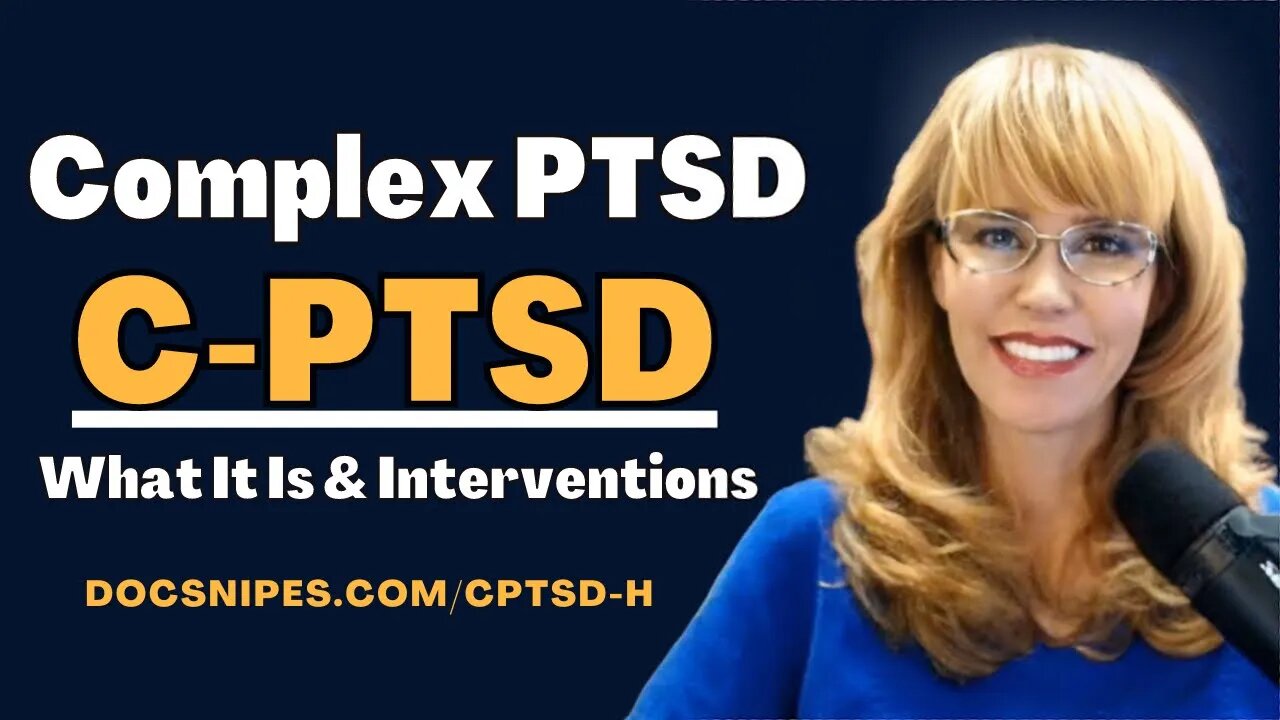Premium Only Content

Complex PTSD (CPTSD) What it is & Strategies to Cope
Complex PTSD (CPTSD) and Strategies to Cope: Read more below:
📢SUBSCRIBE & click the BELL to get notifications
💲 EARN Counseling and Social Work CEUs https://www.allceus.com/member/cart/index/product/id/336/c/
Unlimited CEUs $59 based videos at: allceus.com
Join channel & get access to perks:
https://www.youtube.com/channel/UCAE3JJi8tX7gfhZEXCUGd_A/join
The video is a BRIEF introduction to what CPTSD is, why it is different from PTSD, how it is related to trauma and why many people have difficulty recovering (HINT: They are trying to address the symptoms instead of the CAUSES of the symptoms) #CPTSD #complexptsd #trauma #BPD
Internal Family Systems Theory #IFS #EMDR #Yoga and #meditation all have their place in treatment of CPTSD but can be very triggering if not implemented carefully and at a time appropriate for the individual.
Unlike single incident PTSD, cPTSD creates a pervasive feeling of unsafeness and disempowerment in most situations. However, like PTSD and BPD, helping the person develop a sense of safety and empowerment then integrating the traumatic experiences can help decondition traumatic stimuli and integrate trauma memory fragments that are stored in the amygdala and throughout the body.
CPTSD: What It Is and Helpful Interventions
PTSD Occurs after a single event.
CPTSD is associated with multiple forms of prolonged/sustained or repeated interpersonal trauma
CPTSD resulted in significantly greater functional impairment than PTSD
Intro
CPTSD includes the core PTSD symptoms of re-experiencing, avoidance, mood alterations, cognitive alterations, hypervigilance and dysregulation in
Emotion regulation
Self-organization (including bodily integrity)
Relational security
Note: CPTSD is not accepted as a psychiatric diagnosis in the Diagnostic and Statistical Manual V
Intro
There is significant overlap between the symptoms of BPD and cPTSD
All of the new or revised PTSD symptoms (which also overlap with BPD symptoms) are cardinal features of cPTSD: Affect dysregulation, altered core beliefs about self, reckless or dangerous impulsive behavior, self-harm
2 BPD criteria related to attachment disorganization or insecurity are not included in the diagnosis of PTSD or cPTSD: terror of abandonment or rejection, and alternating idealization and devaluation*
Traumatic experiences and a compromised primary attachment have been hypothesized as key contributors to BPD
Adults with BPD also are at risk for abuse or re-victimization in adulthood
Treatment
Education Many people with CPTSD think that their symptoms represent an innate constitution and have not recognized the association with trauma.
Create safety
Develop somatic and emotional awareness (Yoga, meditation)
Empower with IFS to heal the parts of themselves that were developed in the context of trauma
Memory integration (EMDR)
Addressing underlying issues instead of simply struggling with symptoms in the present
Symptoms Safety & Empowerment
• Physical
• Dizziness or nausea when remembering the trauma
• Always tense
• Startling easy
• Difficulty sleeping
• Impulsive behaviors including self-harm
• Affective
• Emotional dysregulation /Lability
• Depression
• Anxiety
• Shame
• Guilt
• Feeling afraid for no obvious reason
• Cognitive
• Reliving the trauma through flashbacks and nightmares
• Difficulty concentrating
• A negative self-view
Symptoms
• Environmental
• Avoiding situations that remind them of the trauma
• Hypervigilance
• The belief that the world is a dangerous place
• Relational
• A loss of trust in the self or others
• Problems with maintaining relationships (switching, trust, rages)
• Feeling detached from oneself
• Feeling different from others
• Low levels of social support
• Rescuing
• Attracted to people who are emotionally unavailable
Summary
Ongoing or repetitive traumas alter the person’s schema, increase the number or trauma related stimuli, cause structural changes to the brain and promote the development of survival strategies such as dissociation which can lead to a pervasive sense of disempowerment and unsafeness.
These changes ultimately lead to alterations in the HPA-Axis and corresponding problems with emotional regulation, hypervigilance, concentration, relationships and more
Summary
Addressing the superficial symptoms without also healing the underlying causes of those symptoms is like injecting anesthetic to numb a broken leg, but never setting it.
CPTSD, PTSD and BPD are all strongly correlated to trauma. Addressing the symptoms the person is experiencing and the causes of those symptoms is far more important than arguing about a diagnostic label.
Until people feel safe in their skin as well as their environment, they will continue to experience symptoms.
NOTE: VIDEOS are NOT a replacement for medical advice or counseling from a licensed professional, but for educational purposes.
00:00 cPTSD
00:14 Intro
07:53 Treatment
13:28 Symptoms
27:28 Summary
-
 8:52
8:52
DocSnipes
1 year agoHow Cognitive Distortions Contribute to Violence
282 -
 1:44:25
1:44:25
Redacted News
2 hours agoElection Day Disaster for Trump? Europe preps for WAR against Russia, Israel's PR failure | Redacted
71.5K66 -
 16:44
16:44
Russell Brand
3 hours agoAmerica’s Hidden Royalty
14.9K18 -
 LIVE
LIVE
StoneMountain64
4 hours agoBattlefield REDSEC leveling guns for attachments
258 watching -
 LIVE
LIVE
Wayne Allyn Root | WAR Zone
7 hours agoWatch LIVE: The War Zone Podcast with Wayne Allyn Root
21 watching -
 33:39
33:39
LibertyRoundTable
3 hours agoWarhawk Down: Dick Cheney’s Legacy & the Rise of Citizen Journalism | LRT Radio 11/4/25”
12 -
 2:05:29
2:05:29
The Quartering
4 hours agoEscape From New York, Harvard Bombers Caught, Trump DEFIES Court On SNAP, Bomb Threat On Plane!
153K87 -
 16:30
16:30
Clintonjaws
19 hours ago $8.35 earned'The View's' Producer Stops Show & Forces Whoopie To Correct Lie
32.5K19 -
 10:51
10:51
Scammer Payback
2 hours agoScammer's Meltdown after He's Been Hacked
3.72K3 -
 LIVE
LIVE
LFA TV
20 hours agoLIVE & BREAKING NEWS! | TUESDAY 11/4/25
1,323 watching